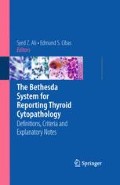Abstract
Ewing coined the term “Hürthle cell” in 1928 based upon the description of a cell made by Hürthle in 1894. The term has become entrenched in the thyroid lexicon, even though Hürthle’s original description is now believed to represent a parafollicular or C-cell of the thyroid gland.1 In 1898, Askanazy was the first to describe the follicular-derived Hürthle cell as we know it today.2 The Hürthle cell (also called Askanazy cell, oxyphilic cell, and oncocyte) is defined morphologically as a thyroid follicular cell with an abundance of finely granular cytoplasm. Most Hürthle cells have an enlarged, round to oval nucleus, and some have a prominent nucleolus.
Access this chapter
Tax calculation will be finalised at checkout
Purchases are for personal use only
References
Hurthle K. A study of the secretory process of the thyroid gland. Arch F D Ges Physiol. 1894:56.
Askanazy M. Pathologisch-anatomische beitrage zure kenntnis des morbus basedowii, insbesondere uber die dabei auftretende muskelergrankung. Dtsch Arch Klin Med. 1898;61:118.
DeLellis RA, Lloyd RV, Heitz PU, Eng C, eds. World Health Organization Classification of Tumours. Pathology and Genetics of Tumours of Endocrine Organs. Lyon: IARC Press; 2004.
Baloch ZW, LiVolsi VA, Asa SL, et al. Diagnostic terminology and morphologic criteria for cytologic diagnosis of thyroid lesions: a synopsis of the National Cancer Institute Thyroid Fine-Needle Aspiration State of the Science Conference. Diagn Cytopathol. 2008;36(6):425-437.
French CA, Alexander EK, Cibas ES, et al. Genetic and biological subgroups of low-stage follicular thyroid cancer. Am J Pathol. 2003;162(4):1053-1060.
Nikiforova MN, Biddinger PW, Caudill CM, et al. PAX8-PPARgamma rearrangement in thyroid tumors: RT-PCR and immunohistochemical analyses. Am J Surg Pathol. 2002;26(8):1016-1023.
Giorgadze T, Rossi ED, Fadda G, et al. Does the fine-needle aspiration diagnosis of “Hurthle-cell neoplasm/follicular neoplasm with oncocytic features” denote increased risk of malignancy? Diagn Cytopathol. 2004;31(5):307-312.
Pu RT, Yang J, Wasserman PG, et al. Does Hurthle cell lesion/neoplasm predict malignancy more than follicular lesion/neoplasm on thyroid fine-needle aspiration? Diagn Cytopathol. 2006;34(5):330-334.
Rosai J, Carcangiu ML, DeLellis RA. Tumors of the thyroid gland. Atlas of Tumor Pathology Fascicle 5. 3rd series. Washington, DC: Armed Forces Institute of Pathology; 1992.
Clark DP, Faquin WC. Thyroid Cytopathology. New York: Springer; 2005:88-102.
Renshaw AA. Accuracy of thyroid fine-needle aspiration using receiver operator characteristic curves. Am J Clin Pathol. 2001;116:477-482.
Amrikachi M, Ramzy I, Rubenfeld S, et al. Accuracy of fine-needle aspiration of thyroid: a review of 6226 cases and correlation with surgical or clinical outcome. Arch Pathol Lab Med. 2001;125:484-488.
Gharib H, Goellner JR, Johnson DA. Fine-needle aspiration cytology of the thyroid: a 12-year experience with 11, 000 biopsies. Clin Lab Med. 1993;13:699-709.
Kini SR, Miller JM, Hamburger JI. Cytopathology of Hurthle cell lesions of the thyroid gland by fine needle aspiration. Acta Cytol. 1981;25(6):647-652.
Nguyen GK, Husain M, Akin MR. Cytodiagnosis of benign and malignant Hurthle cell lesions of the thyroid by fine-needle aspiration biopsy. Diagn Cytopathol. 1999;20(5):261-265.
Wu HH, Clouse J, Ren R. Fine-needle aspiration cytology of Hurthle cell carcinoma of the thyroid. Diagn Cytopathol. 2008;36(3):149-154.
Elliott DD, Pitman MB, Bloom L, et al. Fine-needle aspiration biopsy of Hurthle cell lesions of the thyroid gland: a cytomorphologic study of 139 cases with statistical analysis. Cancer. 2006;108(2):102-109.
Renshaw AA. Hurthle cell carcinoma is a better gold standard than Hurthle cell neoplasm for fine-needle aspiration of the thyroid: defining more consistent and specific cytologic criteria. Cancer. 2002;96(5):261-266.
Takashima S, Matsuzuka F, Nagareda T, et al. Thyroid nodules associated with Hashimoto thyroiditis: assessment with US. Radiology. 1992;185(1):125-130.
Owens CL, Rekhtman N, Sokoll L, et al. Parathyroid hormone assay in fine-needle aspirate is useful in differentiating inadvertently sampled parathyroid tissue from thyroid lesions. Diagn Cytopathol. 2008;36(4):227-231.
Author information
Authors and Affiliations
Editor information
Editors and Affiliations
Rights and permissions
Copyright information
© 2010 Springer Science+Business Media, LLC
About this chapter
Cite this chapter
Faquin, W.C., Michael, C.W., Renshaw, A.A., Vielh, P. (2010). Follicular Neoplasm, Hürthle Cell Type/Suspicious for a Follicular Neoplasm, Hürthle Cell Type. In: Ali, S., Cibas, E. (eds) The Bethesda System for Reporting Thyroid Cytopathology. Springer, Boston, MA. https://doi.org/10.1007/978-0-387-87666-5_6
Download citation
DOI: https://doi.org/10.1007/978-0-387-87666-5_6
Published:
Publisher Name: Springer, Boston, MA
Print ISBN: 978-0-387-87665-8
Online ISBN: 978-0-387-87666-5
eBook Packages: MedicineMedicine (R0)

